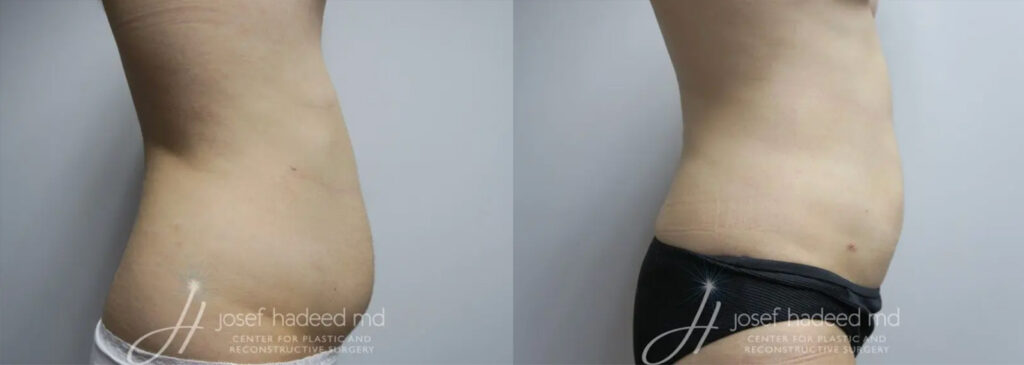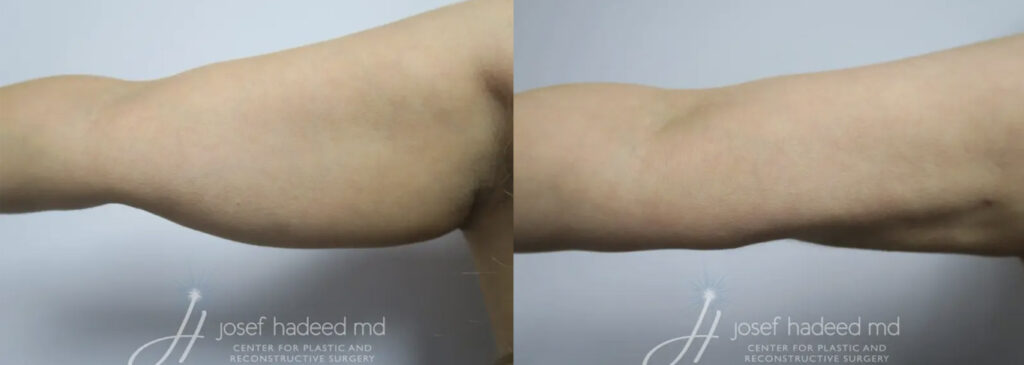Is Liposuction Dangerous?
Posted May 14, 2025 in Body Procedures by Josef Hadeed, MD

Are you considering undergoing liposuction surgery to remove excess fat deposits but are worried about whether it’s safe? Liposuction for men and women is among the most requested cosmetic procedures, but it is still surgery, so concerns about its safety are natural. As with all plastic surgery procedures, it’s always a good idea to be aware of the potential risks and side effects of liposuction so you know how to manage them. Beyond bruising or swelling, patients also fear rare injuries to nerves, blood vessels, or abdominal organs. In this blog, we’ll explore why modern, safe liposuction techniques keep those structures protected, which factors raise risks, and how to decide if liposuction is the right procedure for you.
8 Min Read:
Table of Contents
- Is Liposuction Safe?
- Types of Liposuction
- Expected Side Effects of Liposuction
- Potential Complications of Liposuction
- Who Is a Good Candidate for Liposuction Surgery?
- Is Liposuction Dangerous for Overweight Patients?
- How Much Fat Can Safely Be Removed During Liposuction?
- Reducing Your Liposuction Risks
- Liposuction Recovery and Aftercare
- Liposuction Options in Beverly Hills, CA
Is Liposuction Safe?
As most people know, liposuction is a surgical procedure designed to remove stubborn fat deposits from nearly anywhere on your body. Liposuction is not a weight-loss procedure but a body-contouring technique intended to put the finishing touches on your figure. Whether you want to improve the appearance of a double chin or remove excess belly fat, the effects of liposuction can be a life-changing experience.
Liposuction for excess fat removal is considered safe when performed by a board-certified plastic surgeon with extensive experience in the surgery. In fact, according to the American Society of Plastic Surgeons (ASPS), close to 350,000 liposuction surgical procedures were performed in 2023 with minimal liposuction complications. Tumescent liposuction is often regarded as the safest liposuction procedure due to its ability to minimize bleeding and reduce complications. In general, this fat reduction treatment is a low-risk surgery with a high reward. However, like any surgery, it does carry some risks.
The keys to making liposuction safe for removing excess fatty tissue include the following:
- Choosing a highly experienced, board-certified plastic surgeon
- Being a good candidate for the fat removal procedure
- Closely following your surgeon’s preoperative and postoperative instructions
- Understanding what a traditional liposuction procedure can and cannot do
Additionally, wearing a compression garment during recovery is important for minimizing side effects such as swelling and discomfort.
Types of Liposuction
There are several liposuction methods, each offering unique benefits and risks.
- Traditional Liposuction: uses a cannula to manually remove unwanted excess fat.
- Tumescent Liposuction: utilizes a local anesthetic to numb the area and reduce bleeding, making the procedure safer and more comfortable.
- Ultrasound-Assisted Liposuction (UAL): employs sound waves to break down fat cells, facilitating their removal.
- Laser-Assisted Liposuction: uses a high-intensity laser to liquefy fat deposits, allowing for easier extraction.
- Power-Assisted Liposuction (PAL): features a special cannula that moves in a rapid back-and-forth motion to break down fat cells more efficiently.
- VASER Liposuction: utilizes ultrasound technology to emulsify the fat, making it a popular choice for those seeking a less invasive procedure.
Each liposuction method has its advantages, and the best liposuction technique depends on your specific needs and goals.

Expected Side Effects of Liposuction
After liposuction for fat removal, you will experience some temporary, easily managed side effects as your body heals. The expected side effects of liposuction surgery typically improve within days or weeks of your recovery period and include:
- Swelling
- Bruising
- Soreness or discomfort
- Temporary loss of skin sensation (numbness)
- Mild fluid drainage
- Minor bleeding
Damage to blood vessels can cause pronounced bruising, blood clots, and impaired circulation. Smoking and aggressive cannula also raise this risk.
Potential Complications of Liposuction
While complications after a liposuction surgical procedure are rare, they can happen, especially if an unqualified provider performs your plastic surgery or you have conditions that make you an unsuitable candidate. More serious liposuction risks during the recovery period include:
- Excessive swelling in the treated area
- Infection
- Blood clots, including deep vein thrombosis (DVT)
- Fat embolism
- Uneven fat removal and irregular contours in the treated area
- Permanent altered skin sensation in the treated area
- Anesthesia complications
Laser liposuction carries the risk of thermal burns, so it is crucial to choose a highly experienced surgeon to minimize this potential complication.
Liquid lipo side effects include potential risks such as pain, swelling, numbness, and infection. While liquid lipo can yield effective results, it is important for patients to be aware of these possible adverse effects so they can make informed decisions.
It’s a good idea to ask your surgeon about the expected side effects of liposuction, how often they run into complications during fat removal surgery, and how they handle emergencies. It’s a sign of a good provider when they are transparent with their answers and prepared for all situations.
Who Is a Good Candidate for Liposuction Surgery?
Besides being performed by a board-certified plastic surgeon, liposuction for fat removal is safest when the patient is considered a good candidate for the procedure. Ideal candidates for a liposuction procedure include those who:
- Are in good overall health
- Are nonsmokers
- Are at or near their healthy target weight
- Have good skin elasticity, as poor skin elasticity can lead to excessive swelling and uneven results post-procedure
- Have realistic expectations for their results
Patients with loose skin may require additional surgical procedures, such as an arm lift or tummy tuck (abdominoplasty) in Beverly Hills, to improve skin tightness after fat removal. Dr. Hadeed’s signature TriDef® liposculpting procedure includes Renuvion® skin tightening to improve the appearance of loose, sagging skin.
Knowing that you’re a good candidate for liposuction surgery before undergoing the procedure helps ensure that your surgery and recovery are safe and that you receive the results you desire.

Is Liposuction Dangerous for Overweight Patients?
This is a very common question, and the answer is that it depends.
Body Mass Index (BMI) and Eligibility
Some surgeons want their liposuction patients to have a body mass index (BMI) below 30 and ideally between 19 and 24. The higher your BMI, the more likely you are to have liposuction complications. However, BMI is not always a good indicator, as it doesn’t discern between the percentage of muscle and the percentage of fat. But if you are truly overweight or obese and have cardiovascular disease, you may not be a good candidate for liposuction. Additionally, gaining weight after liposuction can adversely affect the aesthetic results.
Surgical Risks
Contrary to what people may think, liposuction surgery is not a method of or substitute for weight loss. Instead, it is a procedure to help remove excess unwanted fat that is resistant to exercise and a healthy diet. Surgeons typically recommend that patients be within ten to twenty percent of their ideal body weight for the best results and safest outcomes. If you are significantly overweight or obese, your risks increase, including anesthesia complications, blood clots, fat embolism, deep vein thrombosis, poor incision healing, and unsatisfactory results. While fat in the treated areas is permanently removed, the remaining fat cells can expand with weight gain. Therefore, it is important to maintain a stable weight to avoid adverse effects on the liposuction results.
How Much Fat Can Safely Be Removed During Liposuction?
No hard regulations exist for how many fat cells can safely be removed during a single liposuction operation. However, the ASPS offers safety guidelines around how much fat can be removed during a single liposuction session. Most surgeons follow the ASPS guidelines to ensure liposuction safety, which says that five liters (around 11 pounds) is the largest amount of fat cells that can be safely removed in one surgery.
Removing more fat cells than that increases your risk of complications, dangerous fluid imbalances, and poor results.
Reducing Your Liposuction Risks
While we’ve covered most of the things you can do to ensure a safe liposuction procedure, they’re worth repeating, including:
- Verify Credentials: The safest liposuction procedures are performed by board-certified plastic surgeons. Verify your surgeon is certified by the American Board of Plastic Surgery.
- Review Photo Galleries: Your surgeon’s before-and-after photos will show the quality of the surgeon’s work and the results they’ve achieved for patients with body types similar to yours.
- Share Full Health History: Tell your surgeon details about your medical history, including medications, supplements, and previous surgeries, even if you think they aren’t relevant.
- Following Every Instruction: The surgeon’s pre- and postoperative instructions are designed to prevent complications like infection and ensure proper healing and beautiful results.
- Honor Recovery Time: Don’t rush your recovery; give your body the rest, care, and nutrition it needs to heal fully.

Liposuction Recovery and Aftercare
Proper postoperative care and recovery are vital to minimizing complications and ensuring the best possible results after liposuction. Wearing compression garments helps reduce swelling and supports the treated areas to assist healing during your recovery. Your surgeon will prescribe medications to manage pain and discomfort; it’s important to take them as directed. Avoiding strenuous activities for several weeks is important to allow your body to heal properly.
Maintaining a healthy diet and regular exercise routine will help prevent weight gain and promote skin tightening. The recovery period can vary depending on the individual and the extent of the procedure, but most people can return to their usual activities within a few weeks. Following your surgeon’s instructions and attending all follow-up appointments will ensure a smooth and safe recovery and help you achieve the results you desire.
Liposuction Options in Beverly Hills, CA
If you’ve been struggling with areas of stubborn fat that won’t budge despite your best efforts, liposuction in Beverly Hills, CA, can provide a stunning, long-lasting solution for enhancing your shape.
If you’re searching for a surgeon with unparalleled experience performing cosmetic procedures such as liposuction to remove stubborn fat deposits, look no further than board-certified plastic surgeon in Beverly Hills Dr. Josef Hadeed.
Dr. Hadeed is certified by the American Board of Plastic Surgery and has years of experience performing safe and effective body-contouring in Beverly Hills, including multiple liposuction methods such as tumescent liposuction, ultrasound-assisted liposuction, power-assisted liposuction, laser lipo, VASER liposuction, and traditional liposuction techniques. To schedule your consultation with Dr. Hadeed, call our office today at (310) 970-2940 or request an appointment online.

